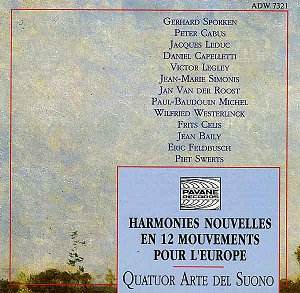 Composer: Maud Powell
Composer: Maud Powell
Works: Powell complete recordings Vol 2; JS BACH Sonata No 3 Movements 1 and IV, HANDEL Xerxes, largo, MOZART Divertimento K334, Minuet, BOCCHERINI arr POWELL Quintet Op 13 No 5, Tempo di Minuetto, MARTINI arr POWELL Plaisir d’amour, VIEUXTEMPS Bouquet americain Op 33, St Patrick’s Day Polonaise Op 38, WIENIAWSKI Violin Concerto No 2 Op 22, Romance, Capriccio Valse Op 7, SCHUBERT Ave Maria, Rosamunde Op 26, Entr’acte III, RAFF Cavatina Op 85 No 3, ZARZYCKI Mazurka Op 26, SCHUMANN Kinderszenen, Op 15, Traumerei, GRIEG arr MARCOSSON To Spring, LEYBACH Fifth Nocturne Op 52, OFFENBACH Les Contes d’Hoffmann, Barcarolle, OGAREW Caprice Op 51 No 2, CHOPIN arr MacMILLEN The Maiden’s Wish, MASSENET Les Erinnyes, Elegie, POLDINI arr HARTMANN Poupee-valsante, CADMAN Little firefly
Performers: Maud Powell, violin; Arthur Loesser, piano; Waldemar Liachowsky, piano; George Falkenstein, piano; Francis J Lapitino, harp; Orchestra conducted by Josef A Pasternack
Recording: Recorded between 1904-1917
Label: NAXOS HISTORICAL 8.110962 [76.04]
Maud Powell occupies a unique position in the pantheon of American violinists, not merely as a performer but as a cultural pioneer who championed the violin repertoire during a transformative era in music history. This second volume of her complete recordings, spanning the years 1904 to 1917, offers a fascinating glimpse into the artistry of a musician who shaped the American musical landscape while navigating the transition from the Romantic to the early Modern era. The selection of works showcases a broad range of styles, from Bach and Handel to Wieniawski and Massenet, reflecting Powell’s eclectic interests and her commitment to both European and American composers.
The recordings reveal both the strengths and limitations of Powell’s interpretative choices. In Bach’s Sonata No. 3, the First Movement exhibits her characteristic portamenti and a juddering rallentando, though one notes a dry tonality that might appeal more to contemporary sensibilities than to modern tastes. The Fourth Movement is particularly notable for its vivacity; Powell’s clean articulation and expressive diminuendos are striking, even if the rapidity leads to some moments of tenuous synchronization with pianist Arthur Loesser. This tension between interpretative flair and technical precision is a hallmark of Powell’s style, exemplifying the historical context of her playing—a blend of late Romantic idealism with a burgeoning sense of modernity.
The interpretation of Handel’s “Xerxes” provides an insightful contrast. Powell’s decision to forgo portamenti in the opening phrase speaks to her instinctive grasp of musical architecture, prioritizing clarity over the lushness that characterizes many of her contemporaries. The tone, while lacking in lyrical intensity, carries a certain straightforwardness that can be refreshing in a period often marked by excessive sentimentality. The Mozart Divertimento further demonstrates her command of tempo, though the lower strings occasionally sound dry, which is a recurring technical issue across several pieces in this collection.
Powell’s renditions of Vieuxtemps’ “Bouquet americain” and the “St. Patrick’s Day Polonaise” showcase her virtuosic capabilities. The former features a delightful use of pizzicatos and a fluid bowing technique that brings out the piece’s inherent charm, while the latter is executed with a flair that, while not always precise, speaks to her exuberant musical personality. However, the Romance from Wieniawski’s Violin Concerto, while imbued with lyric intensity, reveals occasional intonation issues that detract from the overall effect.
Recording quality, as expected from the era, presents some challenges, particularly with surface noise that compromises the clarity of the performances. The remastering efforts by Ward Marston have enhanced certain aspects, yet the presence of “chuffing” on the Vieuxtemps and “swishing” during Massenet’s Elegie remains a concern. These sonic imperfections, however, do not entirely overshadow Powell’s interpretative insights, which often transcend the limitations of the recording technology available at the time.
The compilation concludes with a rather tepid rendition of Cadman’s “Little Firefly,” which lacks the engagement and vibrancy that characterize much of Powell’s playing. This final piece, symptomatic of a stylistic shift in the early 20th century, feels like an unceremonious end to an otherwise compelling collection.
Powell’s legacy as a trailblazing performer is well served by this release, which captures the essence of her artistry while also inviting critical reflection on the evolution of violin performance practices. The collection is significant not only for its historical value but also for the insights it provides into the interpretative choices of a musician grappling with the rapid changes in the musical landscape of her time. The careful remastering and the accompanying notes by Karen Shaffer enhance the listening experience, providing context to Powell’s life and work. This volume is an important addition for anyone interested in the early 20th-century violin repertoire and the evolution of performance style in a rapidly changing musical world.



